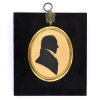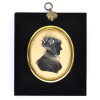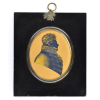Atkinson, George
Introduction:
Prolific, versatile and initially an itinerant profilist, GEORGE ATKINSON (ca.1785-1851) is best known as a Brighton-based artist, working there between 1817-ca.1827. Curiously, evidence of his career after 1827 until his death in 1851 is extremely sparse.
Thought to have painted exclusively on card and paper, several recently sourced 1809-1812 newspaper advertisements show him also offering works "...in the manner of Hamlet of Bath" on glass and ivory and evidence two short-lived 'partnerships'.
Though 8 trade labels are known, his recorded output is often unlabelled and unsigned, causing occasional misattributions. In the main this is due to the fact that when, for reasons unknown, Atkinson departed Brighton, George Crowhurst (1795-1839) stepped into the vacuum, becoming an adroit copier of Atkinson's style, particularly when painting 'stock' profiles of royalty.
Virtually all Atkinson's extant works are bust-sized with bustline terminations showing considerable variation. Some early profiles are recorded in oval fruitwood frames, though the bulk sit in papier mâché frames which, like the profiles they house, vary in size. Body colour can be black, grey, grey-green or sepia, while Chinese white, coloured and bronze highlights are known. Bronzed profiles often show considerable skill and McKechnie rated the best of his brushwork almost as skilful as John Field's, which is praise indeed. Interestingly, 2 bronzed profiles, one in the MUSEUM of WALES collection, one in private hands, show Atkinson painted their card grounds 'Wedgewood Blue' before painting in the sitters. Stylistically, both can be attributed to Atkinson, who appears the sole profilist to offer this extremely rare style of presentation.
Also virtually unique are 3 recently discovered full-length silhouettes. Atkinson signed all with surname and initial - a previously unrecorded trait.
The first, inscribed 'G. ATKINSON 1827 LANCASHIRE', depicts two children and perhaps their grandfather. Painted in grey body colour with black and Chinese white highlights, they stand in a well-painted landscape housed in a frame of maplewood.
The second, signed 'G. ATKINSON 1832', depicts a young bonneted woman standing before a rustic bridge flanked by trees and shrubs. The composition is painted with notable care. The figure has dark grey body colour and bronze, Chinese white, light blue and black highlights.
The third, of a mounted, bronze-highlighted cavalryman, signed 'G. ATKINSON', sold at Bonhams (Massachusetts) on the 29th February 2024.
In addition, prints of several full-length watercolours painted by Atkinson of royalty, were published by him in Brighton in 1825. One of the series, a print of the Duke of York (1763-1827), is in the National Portrait Gallery collection.
Initially perhaps, he was recorded in the MORNING POST of 24th of January 1805. In London, a "Mr.Atkinson" was commissioned to paint a portrait. It was unfavourably received. Refused his fee, Mr.Atkinson assaulted his client - an event that warranted a caricature of the incident. However, confirmed evidence first appears in the STAMFORD MERCURY of 15th of September 1809, when "ATKINSON and MURLEY" offered "...correct likenesses in the manner of Hamlet of Bath by means of a newly invented machine". Terms were "Black on Vellum 5s., Glass 8s. Reduced for Rings, Broaches &c...[with]...Old profiles accurately copied". The partnership was brief, as was "ATKINSON and RIPPINGILLE". Advertising in the BURY AND NORWICH POST between April and June 1810, they also offered portrait miniatures from 3 to 5 guineas. Though Murley is lost to history Rippingille was likely Edward Villiers Rippingille (dec.1859), a self-taught artist born in Lynn, Norfolk.
Henceforth Atkinson worked alone, and between June and September 1810 he assured readers of the IPSWICH JOURNAL he had taken "...a greater number of likenesses than any of his profession in the Universe" (!) In October, profiles on glass and ivory were again offered in the SUFFOLK CHRONICLE, and for the first time he describes himself a "Profilist from London". A final advertisement was placed in the TAUNTON COURIER in November 1812, after which trade labels plot his career.
Used in Devon, printed trade labels style him a "Bronze Profilist", and he later untruthfully promoted himself inventor of the technique. He also advertises himself as from London's Strand. Recently sourced, a further label specifically locates him at "Mr. Slater's in the Strand". 1805-1820 directories list John Slater of 35 Strand a jeweller, silversmith and sword cutler. Evidently Atkinson operated from a 'studio' there some time between 1805-1817, after which he decamped to Brighton.
Brighton-based until ca. 1827, at least 2 offspring were born there. Recorded at 3 addresses, the last, 40 Old Steine, was occupied in turn by profilist George Crowhurst. As Crowhurst found a consistent living there until his death in 1839, it's strange that Atkinson moved away. Where he operated after 1828 is uncertain, though it's likely he was the "Mr.Atkinson" who established the "Royal Saloon of Arts" at Windmill Hill in Gravesend, Kent in 1839, and it appears his 3rd son John (born 1827) was employed there. In the SOTH EASTERN GAZETTE 8th July 1845, described as a 'Portrait Painter' , John Atkinson was charged with ' plying his worldy calling' at Windmill Hill on the Sabbath and fined 5 shillings. Certainly 2nd son Frederick (1825-1905) is recorded there, and later at the Rosherville Gardens, another Gravesend pleasure ground, well into the 1860s.
Evidence of Atkinson's family was recently discovered in the 1841 Census of London Street., Bethnal Green. Atkinson is listed an "Artist" aged 56, wife Ellen is 51, son William, 24, a "Painter", Caroiline, 20, is "Independent", Frederick, 18 and John, 14, are "Artists", and without occupations were Thomas, 12 and Mary (Ann), 8.
Seemingly striving to give his offspring artistic groundings, only Frederick is known to have earned a sustained living as an artist. Caroline died a laundress in Bethnal Green in 1893, while the histories of his other children eluded definative research. An absence of records also indicates it unlikely he was legally wed or christened his children. The fact that Caroline and Frederick's Brighton birthplaces are known only from later census returns and that Frederick was 35 when baptised bolsters this theory.
The 1851 Census lists Atkinson "Artist Portraits" aged 64, born in Lincoln,.wife Ellen, 59, born in Durham, and daughter Mary Ann, 19, "Artist in Portraits" born in Islington. Then lodging in Prospect Place, Bethnal Green, a contemporary survey described it as ' untidy'- which was generally a euphemism for squalid. Doubtless Atkinson was in straitened circumstances.
His death was registered as occurring between April-June 1851 in Bethnal Green. His interment is unrecorded.
REVISED: 21 May 2023 (Brian Wellings)
Additional research about George Atkinson:
Source: McKechnie (Author of, British Silhouette Artists and their Work 1760-1860)
Atkinson, George (McKechnie Section 1)Atkinson, George (McKechnie Section 2)
Atkinson, George (McKechnie Section 6)
Source: Joll (Hon. Secretary of the Silhouette Collectors Club and Editor of the Club's newsletter)
Atkinson, George (SCC Newsletter June 1998)


